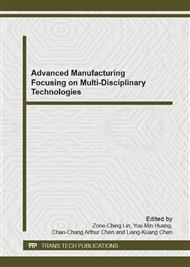p.160
p.174
p.184
p.193
p.201
p.211
p.219
p.227
p.235
Removal Analysis for Multi-Axial WEDM and Ultrasonic Assisted WEDG Processes with Augmented Rotational Axes
Abstract:
Rotational axes augmented to general Wire Electrical Discharge Grinding (WEDG) and to the cylindrical wire EDM processes (CWEDM) are reported in this study. On their removal mechanism, a quantitative analysis based upon wire EDM discharge-angle is proposed to clarify comprehensive understanding of the novel mechanisms. The proposed quantitative analysis provided a better understanding for multi-axial WEDG and WEDM processes. Besides, an ultrasonic assisted UA-WEDG system associated with a conic oil cup was then developed in this study to improve the machining efficiency and the surface integrity by improving debris processes. Its significant effects on dressing processes of micro tools were verified experimentally and some removal saturation for both configurations were discussed. Dressing effects meso-scaled rod and screw by both CWEDM and WEDG mechanism were also compared and discussed.
Info:
Periodical:
Pages:
201-210
Citation:
Online since:
October 2012
Authors:
Price:
Сopyright:
© 2012 Trans Tech Publications Ltd. All Rights Reserved
Share:
Citation:


